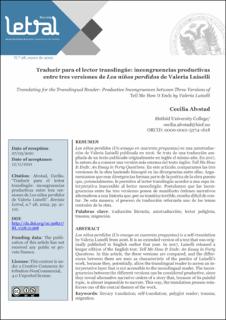| dc.contributor.author | Alvstad, Cecilia | |
| dc.date.accessioned | 2022-05-31T10:05:49Z | |
| dc.date.available | 2022-05-31T10:05:49Z | |
| dc.date.created | 2022-05-02T14:46:07Z | |
| dc.date.issued | 2022 | |
| dc.identifier.citation | Revista Letral. 2022, (28), 91-110. | en_US |
| dc.identifier.issn | 1989-3302 | |
| dc.identifier.uri | https://hdl.handle.net/11250/2996998 | |
| dc.description.abstract | Los niños perdidos (Un ensayo en cuarenta preguntas)es una autotraduc-ción de Valeria Luiselli publicada en 2016. Se trata de una traducción am-pliada de un texto publicado originalmente en inglés el mismo año. En 2017, la autora da a conocer una versión más extensa del texto inglés: Tell Me How It Ends: An Essay in Forty Questions. En este artículo, comparamos las tres versiones de la obra haciendo hincapié en las divergencias entre ellas. Argu-mentamos que esas divergencias forman parte de la poética de la obra puesto que, potencialmente, le permiten al lector translingüe acceder a una capa in-terpretativa inaccesible al lector monolingüe. Postulamos que las incon-gruencias entre las tres versiones ponen de manifiesto órdenes narrativos alternativos a una historia que, por su temática terrible, resulta difícil de con-tar. De esta manera, el proceso de traducción reforzaría uno de los temas centrales de la obra. | en_US |
| dc.description.abstract | Los niños perdidos (Un ensayo en cuarenta preguntas)is a self-translation by Valeria Luiselli from 2016. It is an extended version of a text that was orig-inally published in English earlier that year. In 2017, Luiselli released a longer edition of the English text: Tell Me How It Ends: An Essay in Forty Questions. In this article, the three versions are compared, and the differ-ences between them are seen as characteristic of the poetics of Luiselli’s work, because they, potentially, allow the translingual reader to access an in-terpretative layer that is not accessible to the monolingual reader. The incon-gruencies between the different versions can be considered productive, since they reveal alternative narrative orders of a story that, because of its painful topic, is almost impossible to narrate. This way, the translation process rein-forces one of the central themes of the work. | en_US |
| dc.language.iso | spa | en_US |
| dc.publisher | Departamento de Literatura Española, Universidad de Granada | en_US |
| dc.rights | Navngivelse-Ikkekommersiell 4.0 Internasjonal | * |
| dc.rights.uri | http://creativecommons.org/licenses/by-nc/4.0/deed.no | * |
| dc.subject | traducción literaria | en_US |
| dc.subject | autotraducción | en_US |
| dc.subject | lector políglota | en_US |
| dc.subject | trauma | en_US |
| dc.subject | migración | en_US |
| dc.subject | literary translation | en_US |
| dc.subject | self-translation | en_US |
| dc.subject | polyglot reader | en_US |
| dc.subject | trauma | en_US |
| dc.subject | migration | en_US |
| dc.title | Traducir para el lector translingüe: incongruencias productivas entre tres versiones de Los niños perdidos de Valeria Luiselli | en_US |
| dc.title.alternative | Translating for the Translingual Reader: Productive Incongruences between Three Versions of Tell Me How It EndsbyValeria Luiselli | en_US |
| dc.type | Peer reviewed | en_US |
| dc.type | Journal article | en_US |
| dc.description.version | publishedVersion | en_US |
| dc.source.pagenumber | 91-110 | en_US |
| dc.source.journal | Revista Letral | en_US |
| dc.source.issue | 28 | en_US |
| dc.identifier.doi | https://doi.org/10.30827/rl.vi28.21368 | |
| dc.identifier.cristin | 2020749 | |
| cristin.ispublished | true | |
| cristin.fulltext | original | |
| cristin.qualitycode | 1 | |

